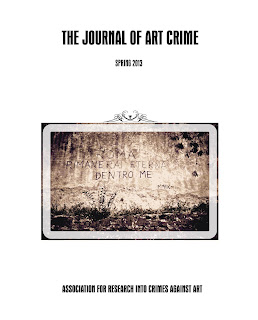Tuesday, August 20, 2013 -  art forgery,interview,Ken Perenyi,Noah Charney,Spring 2013,the Journal of Art Crime
art forgery,interview,Ken Perenyi,Noah Charney,Spring 2013,the Journal of Art Crime
 No comments
No comments
 art forgery,interview,Ken Perenyi,Noah Charney,Spring 2013,the Journal of Art Crime
art forgery,interview,Ken Perenyi,Noah Charney,Spring 2013,the Journal of Art Crime
 No comments
No comments
Noah Charney's "Q&A with Ken Perenyi" (The Journal of Art Crime, Spring 2013)
Noah Charney, ARCA Founder and Editor of The Journal of Art Crime, interviews Ken Perenyi, American art forger and author of Caveat Emptor, in the Spring 2013 issue.
Noah Charney: Could you begin by telling me about the very first work that you forged, the process of making it, and what made you turn to creating a work that would be passed off as something it was not?
Ken Perenyi: The first one was a matter of circumstance that led me to it. I found myself in a great need of money when I was 18, and I had already started painting. I had worked under the direction of a well-known commercial artist from New York called Tom Bailey, and I discovered that I had a real natural talent for oil painting. It impressed my mentor, Tom, and I learned to paint simply by looking at Old Masters in museums. I never had lessons or formal training, it was just looking at paintings, studying them, and figuring out how the artists achieved their effects.
I started painting in 1967, with no intention of creating fakes. I wanted to paint surrealistic pictures to impress my friends at the time. The hippy era was big, and my friends from New York City were all avant-garde, they were all older than me. They leased a crumbling old mansion on the Palisade cliffs overlooking the Hudson River, and so I began hanging out there with them. I wanted to fit in and impress them, so I started painting a number of surrealistic pictures. But everyone who looked at them said that they seem to be influenced by the Old Masters -- that wasn't a criticism, just an observation. And that's the way I understood how to paint, to layer and make things appear like the Old Masters.
I spent a lot of time in museums, studying painting. When I found myself in desperate need of cash, an artist friend joked that I should try forging a painting. He gave me a book about the forger [Han] van Meegeren, that he had just finished reading. I was impressed, and in the brashness of youth, I figured, maybe I can do this?
On my next trip to the museum, I visited the Dutch section and was looking at the portraits. I looked at these little portraits, and thought that they've got to be simple. I thought, why don't I try something like this? So I painted one on a small wooden panel that I scavenged, it was the bottom of an early piece of furniture. I managed to make a fine little portrait on the panel, and was able to sell it to a gallery on 57th Street [in New York]. I got $800 for it -- that was my first fake. From that point on, it wasn't a matter of if I would paint another one, but when I would paint another one. It was the beginning of a career -- I didn't look upon it as a career at that point, I saw it as something I could always fall back on, to raise some quick cash, until a turning point came later in life.This interview is continued in the ninth issue of The Journal of Art Crime, edited by ARCA Founder Noah Charney. It is available electronically (pdf) and in print via subscription and Amazon.com. Associate Editor Marc Balcells (ARCA '11) is a Graduate Teaching Fellow at the Department of Political Science, John Jay College of Criminal Justice -- The City University of New York.







